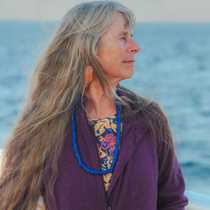San Jose Channel, Isla San Jose & Isla San Francisco
Last night, the National Geographic Sea Bird left the dock at Port Escondido at 10:00pm, heading south for further exploration of the Gulf of California. The El Norte winds continued blowing throughout the night and into the early morning. Long before sunrise our ship hit these strong winter winds and the decision was made to change direction, find calmer seas and rearrange our plans for the day; the expedition part of our trip was about to begin!
Our Expedition Leader made his usual announcements during breakfast explaining the alternative plans for hikes ashore on the northwest side of Isla San Jose. As the National Geographic Sea Bird continued south making her way towards this destination, Gretchen Pederson gave a presentation on the adaptive mechanisms of desert plants, a very appropriate presentation just before making our way ashore to explore a newly stormed-washed arroyo on Isla San Jose.
Once everyone was ashore and divided into our customary hiking groups a wonderfully leisurely, though exploratory, walk began up the arroyo. During the recent summer storm season, Baja California, Sur had been hit by two hurricanes, bringing enormous amounts of rain. As the hiking groups entered the main arroyo it was obvious that a torrent of rain had washed down the island leaving its mark in the sand and rock of the arroyo.
The other indicator was the profusion of plant growth. Though we walked in a desert, the drought deciduous trees, small shrubs and tiny plants had been grateful for the abundance of moisture, showing off gorgeous vegetation.
A small group of long hikers began with a goal of gaining some elevation and hopefully good views out into the Gulf of California. Medium hikers explored the botanical mix of an island located fairly close to the Baja Peninsula affording a unique grouping of plants and animals. The leisurely walk moved up the arroyo stopping often finding both plants and insects not only interesting but also a joy to watch!
A walking stick insect approximately three inches in length showed off its unusual bright green legs, while many species of butterflies danced through the arroyo finding their favorite shrubs in full flower and offering much in the way of food and a place to rest.
As everyone made their way further inland, the arroyo offered protection from the wind and our attention was drawn in, to the beautiful world of the desert’s winter ephemeral plants. So many colors, sizes, and shapes, and all we needed was the time and a good eye to enjoy this brief growing season.
This part of the Sonoran desert experiences cooler temperatures, light rains and moist evenings throughout the winter and when these conditions combine along with the deep watering of the summer storms, the desert becomes a lush garden. It is brief, but on this morning we all realized our luck, in being able to take the time and hear the joy of all our naturalists as each one found yet another natural gift brought to us from the winter desert season.
All too soon we had to pull ourselves away from bushes covered in butterflies, birds, and other insects and many a gorgeous flower to return to our landing and back to the National Geographic Sea Bird. Once all Zodiacs were stowed and everyone was back onboard lunch was served, while our ship began her passage towards our afternoon destination of Isla San Francisco.
On the southwest side of this tiny island is a lovely white beach called Half Moon Bay. The island offers great protection from the El Norte wind and an opportunity for a wonderfully casual afternoon with all water activities available to everyone! Kayaks were brought ashore. Tide pooling was offered and lifeguards were stationed on the beach for swimming and snorkeling. The water temperature was in the low 70’s and wonderfully comfortable. The long expanse of white sand provided a chance for a long walk, while many of us sat back and enjoyed the beauty of this unique place in the world.
Baja: a long peninsula of land, its inside gulf a rich sea with a necklace of islands running along its eastern side, all individual desert environments falling away to the sea.



